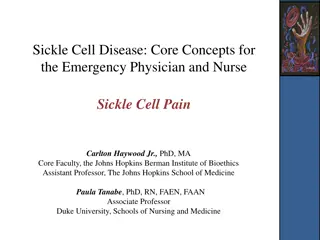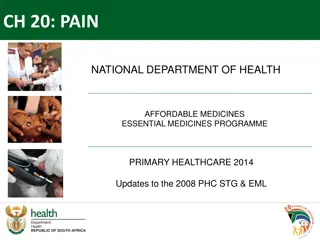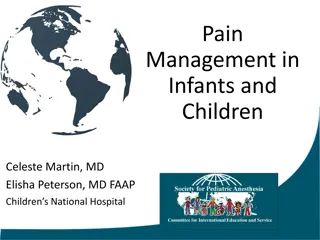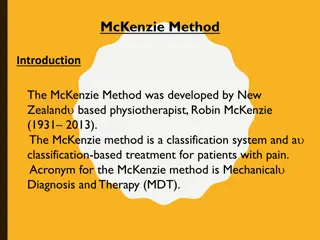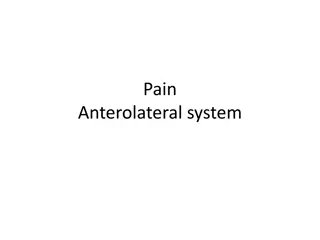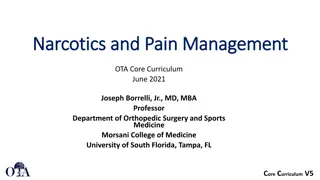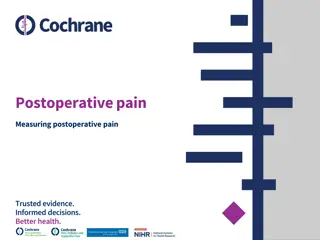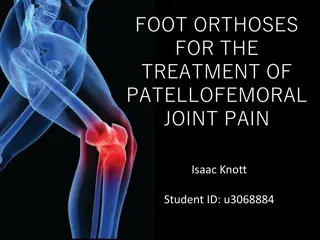Understanding Patellofemoral Pain Syndrome (PFPS) and Its Management
Patellofemoral Pain Syndrome (PFPS) is a common cause of anterior knee pain often related to overuse, malalignment, or trauma. Symptoms include achy pain around the patella, worsened by activities like squatting or running. Diagnosis involves a physical exam to assess patellar mobility and tenderness. Management typically includes rest, ice, and NSAIDs to alleviate pain, along with reducing workout intensity until symptoms subside. Understanding PFPS and its characteristics is crucial for effective treatment.
Uploaded on Sep 16, 2024 | 0 Views
Download Presentation

Please find below an Image/Link to download the presentation.
The content on the website is provided AS IS for your information and personal use only. It may not be sold, licensed, or shared on other websites without obtaining consent from the author. Download presentation by click this link. If you encounter any issues during the download, it is possible that the publisher has removed the file from their server.
E N D
Presentation Transcript
Allison Eliscu, MD, FAAP Rev. Aug 2012
Lower Extremity Injuries Patellofemoral Pain Syndrome Osgood Schlatter Disease Ankle sprains Sever s Disease
What is Patellofemoral Pain Sx? Anterior knee pain involving the patella and retinaculum Must exclude joint and peripatellar damage Most common cause of knee pain Multifactorial etiology: Overuse, patellar malalignment, trauma Anatomic risk Factors: Tight lower extremity muscles Patellar hypermobility Pes cavus (high arch)
History Consistent With PFPS Achy pain behind, underneath, or around patella Gradual onset Pain or stiffness with sitting for long periods of time Pain with squatting, stairs, or running May hear popping or feel knee catching Associated with increase in activity level Frequency, duration, or intensity
Physical Exam of PFPS No Effusion Normal range of motion Normal internal ligament exam Decreased flexibility of IT Band or quadriceps Special patellar tests: Patellar glide Patellofemoral compression test Patellar facet tenderness
Patellar Glide Test Patient supine with knee extended Displace the patella medially Movement < of patella s width = tight retinaculum Movement > of width = hypermobility of patella Both are risk factors for PFPS Lateral Medial Medial Displacement
Patellar Examination Patellofemoral Compression Test Patient supine, knee extended Compress patella posteriorly into femoral trochlear groove Pain consistent with PFPS Patellar Facet Tenderness Displace the patella laterally Palpate the lateral facet (undersurface) Repeat medially Pain consistent with PFPS
Management of PFPS Initial treatment: relative rest, ice, NSAIDS for pain Reduce workout until have no pain Consider nonimpact workout (swimming, biking) Physical therapy Goal: Decrease patellar strain Improve flexibility and strength of surrounding muscles Focus on quadriceps, hamstrings, gastrocnemius, soleus Taping and braces may improve symptoms Consider surgery if no improvement in 6-12 months
Recommended Reading Dixit S, DiFiori JP, Burton M, Mines B. Management of Patellofemoral Pain Syndrome. Am Fam Physician. 2007 Jan;75(2):194-202. Patel DR, Nelson TL. Sports Injuries in Adolescents. Med Clin North Am 2000 Jul;84(4):983-1007. O Connor FG, Mulvaney SW. Patellofemoral Pain Syndrome. UpToDate Online. Updated April 30, 2009.
What is Osgood-Schlatter Disease? Traction apophysitis affecting insertion of patellar tendon on tibial tuberosity Overuse injury ~20% adolescent athletes affected Males > Females Presents in Tanner 2-3 Separation of patellar tendon from tibial tuberosity due to chronic avulsions of apophysis
Clinical Presentation Subacute pain of anterior knee Gradually worsening Pain exacerbated by jumping, squating, and kneeling Relieved with rest Bilateral symptoms in 20-30% of patients
Physical Examination Findings Local tenderness and swelling over tibial tuberosity Pain reproduced by extending knee against resistance Pain with squatting in full flexion Ossicle in tendon may be present Prominence over tibial tuberosity
Management of Osgood-Schlatter X-ray required if atypical complaints present Night pain, acute onset, pain unrelated to activity Continue to participate in sports as tolerated Even if some pain is present Avoidance of activity NOT recommended Ice may improve symptoms Physical therapy Improve flexibility and strength of hamstrings and quads Usually resolves with ossification of growth plate Rarely requires surgery to remove ossicle (only done after closure of growth plate)
Recommended Reading Patel DR, Nelson TL. Sports Injuries in Adolescents. Med Clin North Am 2000 Jul;84(4):983-1007. Kienstra AJ, Macias CG. Osgood-Schlatter Disease. UpToDate Online. Updated September 8, 2008.
Types of Ankle Sprains Posterotalofibular Ligament (PTFL) Lateral Ankle View Anteriotalofibular Ligament (ATFL) Lateral sprain inversion injury Most common (85% of sprains) Involves ATFL most commonly May affect stronger CFL or PTFL Calcaneofibular Ligament (CFL) Medial sprain eversion injury Rare injury Involves strongest ligaments (deltoid) Medial Ankle View
Ankle Sprains Lateral Ankle View Posterotalofibular Ligament (PTFL), Anteriotalofibular Ligament (ATFL), Calcaneofibular Ligament (CFL)
Ankle Sprains Medial Ankle View
High Ankle (Syndesmotic) Sprain Due to dorsiflexion + eversion of ankle with internal rotation of tibia Involves ATFL + PTFL + tibiofibular ligaments + interosseous membrane Critical to ankle stability Frequently leads to recurrent sprains Confirm with MRI and refer to orthopedics
Grading Ankle Sprains Grade I Mild stretch of ligament Mild swelling and tenderness Able to walk with minimal pain Grade II Incomplete tear of ligament Moderate pain, swelling, and bruising Pain with walking Mild decreased range of motion Grade III Complete tear of ligament Severe pain, swelling, and bruising Unable to walk Significantly decreased range of motion
Questions to Ask a Patient Presenting with an Ankle Injury Mechanism of injury History of prior injuries Ability to walk immediately after injury
On Physical Examination Examine for swelling and ecchymosis Palpate fibula, tibia, foot, and Achilles tendon for pain Palpate tip of malleoli, base of 5th metatarsal, and navicular bone for pain Check for pain with passive inversion and eversion Special ankle tests: Squeeze test External rotation test Anterior drawer test Talar tilt test
Ankle Examination Squeeze Test Compress fibula and tibia at mid-calf level Pain in ATFL area suggests high ankle sprain External Rotation Test Stabilize tibia and fibula with one hand Rotate foot externally Pain in ATFL area suggests high ankle sprain
Ankle Examination (Continued) Anterior Drawer Test* Stabilize tibia and fibula with one hand Opposite hand on heel, apply anterior force Compare to uninjured side Excessive displacement is a sign of ligamentous injury Talar Tilt Test* Stabilize tibia and fibula with one hand Invert the foot gently Compare to uninjured side Excessive laxity is a sign of ligamentous injury *Limited use in acute phase motion limited by pain/swelling
Ottawa Rules for Obtaining X-Ray Method of clinically excluding fractures Goals: Avoid unnecessary x-rays in those unlikely to have a fracture Avoid missing fractures High sensitivity (>96%), variable specificity (10-79%) Disregard rules if patient is intoxicated or has impaired sensation **May be less reliable in prepubescent patient with open growth plates**
Ottawa Rules Obtain ankle X-ray if: pain in either malleolus AND Tenderness at tip of malleolus or distal 6 cm of tibia or fibula Can t weight bear immediately after injury AND for 4 steps on examination OR Obtain foot X-ray if: pain in midfoot AND Tenderness at base of 5th metatarsal or navicular bone Can t weight bear immediately after injury AND for 4 steps on examination OR
Management of Ankle Sprains RICE (Rest, ice, compression, elevation) x 2-3 days Crutches until gait is normal Begin exercises early (as soon as edema decreases) Plantar and dorsiflexion exercises and foot circles Early weight bearing with brace to prevent reinjury Usually heal completely in 4-6 weeks Prolonged symptoms (>6-8 wks) require MRI
Recommended Reading Maughan, KL. Ankle Sprain. UpToDate Online. Updated June 4, 2009. Giunta YP, Rocker JA. Sprains. Pediatr Rev. 2008 May;29(5):176-8. Clark KD, Tanner S. Evaluation of the Ottawa Ankle Rules in Children. Pediatr Emerg Care. 2003 Apr;19(2):73-8. Myers A, Canty K, Nelson T. Are the Ottawa Ankle Rules Helpful in Ruling Out the Need for X-Ray Examination in Children? Arch Dis Child. 2005 Dec;90(12):1309-11.
Severs Disease Overuse injury of posterior calcaneous Common cause of heel pain in young adolescents Typically in 8-12 years old males (M:F=3:1) Common in gymnasts, basketball players, soccer players Risk factors: Repetitive jumping and landing from height Decreased flexibility of Achilles tendon and gastrocnemius Affected Area
Severs Disease History Presents as gradual heel pain Worse with running (especially decelaration) Does not affect gait or regular activities Bilateral in 61% of cases Physical Exam Pain reproduced by palpation of posterior calcaneous Decreased flexibility of gastrocnemius and soleus
Management of Severs Disease Ice and NSAIDS acutely for pain control Relative rest Heel pad inside shoes Stretching exercises for gastrocnemius/soleus Strengthen dorsiflexing muscles Usually resolves in 6-8 weeks
Which of the following signs or symptoms is NOT consistent with patellofemoral pain syndrome? A. Effusion surrounding the patella B. Pain with squatting C. Decreased flexibility of quadriceps D. Popping noise with walking E. Pain onset following recent increase in exercise level
Which of the following signs or symptoms is NOT consistent with patellofemoral pain syndrome? A. Effusion surrounding the patella B. Pain with squatting C. Decreased flexibility of quadriceps D. Popping noise with walking E. Pain onset following recent increase in exercise level
Answer: A. Effusion surrounding the patella indicates internal injury (ligamentous or meniscal) and is not consistent with patellofemoral pain syndrome.
A 16 year old runner presents to your office complaining of an achy pain in her right knee. It started a few days ago after she had increased her mileage and added hills to her running routine. Her physical exam is remarkable for tight quadriceps and pain when the patella is pushed posteriorly. You diagnose her with patellofemoral pain syndrome. How should you manage this patient? A. Recommend that she stop exercising until she is pain-free B. Apply heat to the area for 20 minutes twice daily C. Begin physical therapy once the pain has improved to increase flexibility and strength D. Recommend that she use crutches until the pain has resolved E. Both A and C
A 16 year old runner presents to your office complaining of an achy pain in her right knee. It started a few days ago after she had increased her mileage and added hills to her running routine. Her physical exam is remarkable for tight quadriceps and pain when the patella is pushed posteriorly. You diagnose her with patellofemoral pain syndrome. How should you manage this patient? A. Recommend that she stop exercising until she is pain-free B. Apply heat to the area for 20 minutes twice daily C. Begin physical therapy once the pain has improved to increase flexibility and strength D. Recommend that she use crutches until the pain has resolved E. Both A and C
Answer: C. Patients with patellofemoral pain syndrome should be instructed to decrease their exercising to a level that isn t painful and consider changing to a nonimpact workout (i.e., swimming or biking) rather than stopping exercising completely. NSAIDs and ice may be beneficial in the acute setting but heat should not be used. The mainstay of treatment is a physical therapy regimen which should focus on improving the flexibility and strength of the lower extremity, hip abductor, and core muscles.
A 12 year old male basketball player presents to your office complaining of right knee pain which has gradually been getting worse. It gets worse with jumping and running and improves with rest. Findings on physical exam are shown in the picture. What is this patient s diagnosis? A. Patellofemoral pain syndrome B. Patellar dislocation C. Osgood-Schlatter Disease D. Stress fracture of proximal tibia
A 12 year old male basketball player presents to your office complaining of right knee pain which has gradually been getting worse. It gets worse with jumping and running and improves with rest. Findings on physical exam are shown in the picture. What is this patient s diagnosis? A. Patellofemoral pain syndrome B. Patellar dislocation C. Osgood-Schlatter Disease D. Stress fracture of proximal tibia
Answer: C. This patient has a prominence over his tibial tuberosity which is consistent with Osgood- Schlatter disease, traction apophysitis where the patellar tendon inserts on the tibial tuberosity. Patients with patellofemoral pain syndrome tend to have no abnormality on inspection. Those with a patellar dislocation usually have an effusion and a gross deformity and present with acute pain. Patients with a stress fracture may have an effusion.
An 11 year old male presents to your office complaining of left knee pain. The pain has been getting worse over the past few months since he has been playing soccer and gets better with rest. You suspect that he may have Osgood-Schlatter Disease. The most appropriate next step is to: A. Obtain an x-ray of the knee with contralateral side for comparison B. Discontinue all sports until the pain resolves C. Refer him to an orthopedist D. Continue to participate in sports even if it is slightly painful
An 11 year old male presents to your office complaining of left knee pain. The pain has been getting worse over the past few months since he has been playing soccer and gets better with rest. You suspect that he may have Osgood-Schlatter Disease. The most appropriate next step is to: A. Obtain an x-ray of the knee with contralateral side for comparison B. Discontinue all sports until the pain resolves C. Refer him to an orthopedist D. Continue to participate in sports even if it is slightly painful
Answer: D. Osgood-Schlatter is a clinical diagnosis that is based on history and physical exam. X-rays are not needed unless the patient has an atypical complaint (acute pain, pain waking them up, pain unrelated to activity). This is one of the rare times that participating in sports despite pain (as long as the pain is tolerable) is encouraged in order to avoid deconditioning. Referral to orthopedics is rarely necessary in Osgood-Schlatter unless the pain persists despite physical therapy and after closure of growth plates.
Which of the following patients does NOT require an x-ray? A. 12 year old male with some pain in the left malleolus, no tenderness on exam, and able to walk with a limp. An intoxicated 18 year old male with pain in his right ankle, difficult to assess for tenderness on exam, and able to walk without limping. 11 year old female with pain in the left lateral malleolus and tenderness over the distal fibula but able to walk with a limp. D. 19 year old female complaining of pain in the right midfoot area with no tenderness on exam but unable to walk. B. C.
Which of the following patients does NOT require an x-ray? A. 12 year old male with some pain in the left malleolus, no tenderness on exam, and able to walk with a limp. An intoxicated 18 year old male with pain in his right ankle, difficult to assess for tenderness on exam, and able to walk without limping. 11 year old female with pain in the left lateral malleolus and tenderness over the distal fibula but able to walk with a limp. D. 19 year old female complaining of pain in the right midfoot area with no tenderness on exam but unable to walk. B. C.
Answer: A. The Ottawa rules recommend that a patient with pain in either malleolus or midfoot should get an x-ray if they also have either tenderness in the tip of the malleolus or distal tibia or fibula on exam OR inability to bear weight immediately after injury and for at least 4 steps on exam (limping is permitted). The rules may be less reliable in skeletally immature patients as they are at risk for Salter-Harris fractures. The patient in answer A does not qualify for an x-ray. If pain persists for more than a few weeks, he may need an x-ray in the future but will probably not benefit from one now. The intoxicated patient should receive an x-ray since the rules may not be valid in intoxicated patients.
A 12 year old male soccer player is complaining of heel pain for the past 1 months. Pain is worse after playing soccer and his mother has noticed him limping a little bit after games. He has no nighttime symptoms and no pain or limping with regular activities. What is the most likely diagnosis? A. High ankle sprain B. Bone tumor C. Sever s Disease D. Osgood Schlatter Disease




